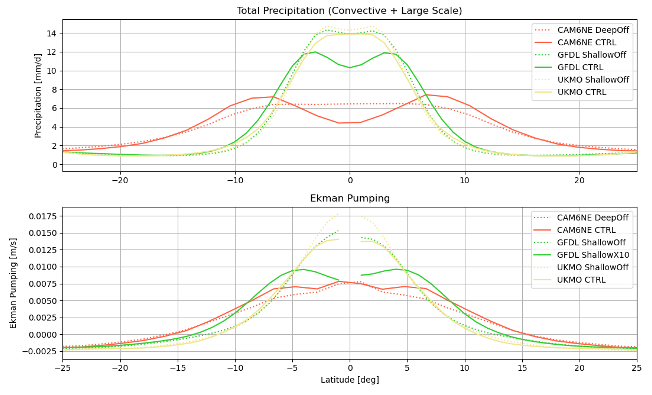(Shallow) cumulus friction experiment
Contact: Louise Nuijens and Nils Hoebe
Despite playing a key role in the atmospheric circulation, the representation and impact of momentum transport by moist convection, in particular shallow convection, has been largely overlooked by the model community over the past decade. The objective of this experiment is to analyze and explain the impact of parameterized (shallow) convective momentum transport (S)CMT on the large-scale overturning Hadley circulation and the structure of the ITCZ in global models.
To the extent that the large-scale circulation is driven by boundary layer wind convergence, convective momentum transport (CMT) may play an important role in setting the intertropical convergence zone and thus strength of the Hadley circulation. This makes parameterized (shallow) CMT an important candidate to take into account when addressing double ITCZ problems in climate models (e.g., Li and Xie, 2014; Lin, 2007; Woefle et al., 2018 & Tian and Dong, 2020). Our overall intent is to address the range of sensitivities of low-level winds and equatorial wind convergence to (s)CMT, and link individual model responses to parameterized CMT.
A protocol for the proposed (Aquaplanet) experiments is described here, which lists a set of three experiments in which either shallow or deep CMT is turned off or their effect is exaggerated. If you would like to participate with experiments, please get in touch, as we are looking for more models.
Current contributing models are CAM, GFDL, UKMO. Preliminary results in the figure below show time- and zonally averaged precipitation and boundary layer Ekman pumping for experiments runs with CAM6 (NCAR) with the NE16 dynamical core; GFDL (NOAA) and UKMO (MetOffice). These reveal different responses that tend to favor more precipitation at the equator without parameterized CMT (whether shallow or deep). This may be linked to stronger Ekman pumping in the equatorial region because a lack of CMT leads to stronger ageostrophic wind turning near the surface.
Preliminary results that visualize the response of the stream function, location and magnitude of zonally averaged precipitation, evaporation and wind patterns for separate models are available here.
A working paper that summarizes results so far will follow soon.


